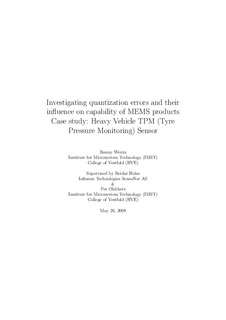| dc.description.abstract | The motivation for this thesis has been to clarify the signi_cance of quantization errors in MEMS (Micro Electro-Mechanical System) products and to see how they combine with normal distribution errors. As a case study, an integrated absolute pressure sensor for the automotive market was chosen. Combinations of errors in such sensors are often treated as if they were simple normal distributions and question was if this is su_ciently correct when considering spread in accuracy and when at the end considering final product capability.
For a product to be capable of meeting its performance speci_cation at the highest possible yield level it is important to find the most correct way of calculating capability. Many natural parameters are normal distributed and in practice one often assumes data distributed such way. This has also been the practice for the heavy vehicle TPM (Tyre Pressure Monitoring) sensor from In_neon Technologies SensoNor, the sensor selected herein as a case study. It has quantization in the signal path. However it is assumed that the errors are normal distributed when calculating its capability. This was background for the establishment of this thesis, with the literal quotation to
To investigate quantization errors and their inuence on capability of MEMS products.
The heavy vehicle TPM sensors are calibrated, meaning errors from digitizing during this process also contributes in the error picture and effects capability.
Theoretical calculations, simulations and measurements are performed. Results are analyzed, compared, and discussed in order to conclude and give design considerations for future products.
All together 4 simulation models were established. The last of the models made, the Final
Model, was the most exible one, being able to simulate both the sensor and the calibration process. Different error contributions from LNA gain change, different ADC resolutions,
and different coeficient round o_s were analyzed and discussed. The sources of errors were
considered such way that it came clear how they contributed to spread isolated and in combination with each other.
Especially in focus through out this work was a specific LNA (Low Noise Amplifier) gain reduction for the heavy vehicle TPM sensor. What change in error contributions such a
reduction of the signal gain before quantization give, and how it at the end effects the total product capability.
It was concluded that a LNA gain reduction results in larger spread in sensor measurement performance, and that it at the end makes the product less capable. It was also
concluded that coefficient round offs, especially round offs for one sensor PROM coefficient
(PZ1PROM), gave significantly increased error on the pressure output signal when reducing
LNA gain. A reduction from LNA gain 16 to LNA gain 10 gave an increase in (PZ1PROM)
round o_ error with a factor of 1.6, from 1.37 to 2.19 kPa for the worst situation (at the
highest temperatures) for 2.5 sensors simulated.
Based on the (PZ1PROM) finding it was recommended to optimize PROM coefficient scalings for future TPM sensor designs. | |
